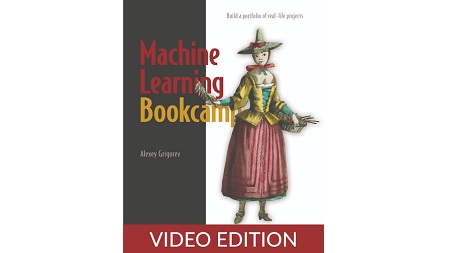
English | MP4 | AVC 1280×720 | AAC 44KHz 2ch | 57 Lessons (8h 59m) | 2.77 GB
Time to flex your machine learning muscles! Take on the carefully designed challenges of the Machine Learning Bookcamp and master essential ML techniques through practical application.
In Machine Learning Bookcamp you will:
- Collect and clean data for training models
- Use popular Python tools, including NumPy, Scikit-Learn, and TensorFlow
- Apply ML to complex datasets with images
- Deploy ML models to a production-ready environment
The only way to learn is to practice! In Machine Learning Bookcamp, you’ll create and deploy Python-based machine learning models for a variety of increasingly challenging projects. Taking you from the basics of machine learning to complex applications such as image analysis, each new project builds on what you’ve learned in previous chapters. You’ll build a portfolio of business-relevant machine learning projects that hiring managers will be excited to see.
Master key machine learning concepts as you build actual projects! Machine learning is what you need for analyzing customer behavior, predicting price trends, evaluating risk, and much more. To master ML, you need great examples, clear explanations, and lots of practice. This book delivers all three!
Machine Learning Bookcamp presents realistic, practical machine learning scenarios, along with crystal-clear coverage of key concepts. In it, you’ll complete engaging projects, such as creating a car price predictor using linear regression and deploying a churn prediction service. You’ll go beyond the algorithms and explore important techniques like deploying ML applications on serverless systems and serving models with Kubernetes and Kubeflow. Dig in, get your hands dirty, and have fun building your ML skills!
The best hands-on guide to begin your machine learning journey.
Gustavo Filipe Ramos Gomes, Troido
Table of Contents
1 Introduction to machine learning
2 When machine learning isn’t helpful
3 Evaluation
4 Machine learning for regression
5 Exploratory data analysis
6 Target variable analysis
7 Machine learning for regression – again
8 Linear regression
9 Predicting the price
10 Validating the model
11 Regularization
12 Using the model
13 Machine learning for classification
14 Initial data preparation
15 Feature importance, Part 1
16 Feature importance, Part 2
17 Feature engineering
18 Machine learning for classification
19 Training logistic regression
20 Model interpretation
21 Using the model
22 Evaluation metrics for classification
23 Confusion table
24 Precision and recall
25 ROC curve and AUC score
26 ROC Curve
27 Parameter tuning
28 Next steps
29 Chapter 5 Deploying machine learning models
30 Model serving
31 Managing dependencies
32 Docker
33 Deployment
34 Decision trees and ensemble learning
35 Data cleaning
36 Decision trees
37 Decision tree learning algorithm
38 Random forest
39 Gradient boosting
40 Parameter tuning for XGBoost
41 Next steps
42 Neural networks and deep learning
43 Convolutional neural networks
44 Internals of the model
45 Training the model
46 Training the model – again
47 Saving the model and checkpointing
48 Data augmentation
49 Using the model
50 Serverless deep learning
51 Preparing the Docker image
52 Serving models with Kubernetes and Kubeflow
53 Running TensorFlow Serving locally
54 Model deployment with Kubernetes
55 Deploying to Kubernetes
56 Model deployment with Kubeflow
57 KFServing transformers
Resolve the captcha to access the links!